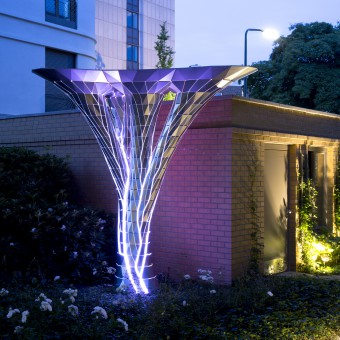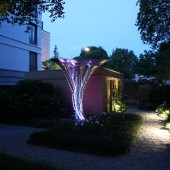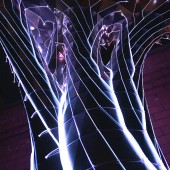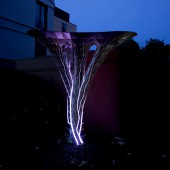Photoptosis Installation by Rajat Sodhi and Christoph Klemmt |
Home > Winners > #65401 |
 |
|
||||
| DESIGN DETAILS | |||||
| DESIGN NAME: Photoptosis PRIMARY FUNCTION: Installation INSPIRATION: The geometries of both the stainless steel surface as well as the fiber optics cables have been developed through computational algorithms that digitally simulate the growth of veins and plants. This venation algorithm simulates the need of plants to reach the sun light or of veins in leaves to supply every cell with nutrients. In doing so, the growth of the branches or the veins slowly expands to cover a large area. UNIQUE PROPERTIES / PROJECT DESCRIPTION: Photoptosis is a sculpture that explores the medium of light as a material that in itself can grow the same way that plants do. Photoptosis consists of a triangulated, tree-trunk-like stainless steel surface, and onto this a set of side-glowing fiber optics cables has grown like the veins of Ivy on a tree. OPERATION / FLOW / INTERACTION: - PROJECT DURATION AND LOCATION: The project is located in Düsseldorf, Germany, completed in 2017. |
PRODUCTION / REALIZATION TECHNOLOGY: The structure is made from 100 stainless steel panels of 3mm thickness that have been CNC-cut and CNC-bent to their respective shapes. The structural engineering managed to only utilize this thin steel surface as the sole structural element, without the need for any primary structure to hang those off. In order for the surface to not deform, additional stainless steel strips were placed in line with the flanges of the panels to stiffen those, and the lower areas required additional bolts along the flanges that connect two rows of steel segments. The foundation is made from concrete and contains a shaft to house the projector for the lighting system. The lighting is achieved by side-glowing fibre-optics cables. The bundle of 200 cables starts at the bottom of the sculpture and then branches out to reach every node on the stainless steel surface. SPECIFICATIONS / TECHNICAL PROPERTIES: 2.5m x 3m x 3.5m height 3mm stainless steel 2mm side-glowing fibre-optics cables TAGS: sculpture, vein, venation, lighting, fibre optics, single surface RESEARCH ABSTRACT: In computational architecture, iterative algorithms such as agent-based simulations or growth simulations can generate interesting, complex geometries. However, while those geometries often present functional aspects, in their application in building designs there are usually various practical requirements that demand the algorithm's output geometry to be different in specific locations. Instead of post-processing and adjusting the geometry after its generation to suit those practical requirements, we propose to incorporate a logic of spatial deformation in the algorithm that is able to increase or decrease the likelihood of geometry being generated in specific areas. The algorithmic calculations in this Curved Space then become an easily controllable tool for the designer. The method has been applied to direct the growth of the lighting system of Photoptosis. The geometry of the surface is slightly bent, moving further away from the viewer at the central height and then coming closer again to the viewer at the top. Although the seed points were placed at the bottom facing the viewer, because of this bending of the sculpture, the shortest paths for the veins to reach the upper target points is along the backside of the sculpture. The resulting distinct branching geometry would therefore be hidden from the viewer and the sculpture would be lit mainly on its backwards facing side. However as the aim of the lighting system is to light the viewer’s side, so the venation algorithms needed to be adjusted to mainly grow on this side of the sculpture. This was achieved by utilising the proposed method of calculation in Curved Space. The spatial deformation in this case was dependent on the proximity to the viewer. It was therefore very simple to use the viewer’s position as the attractor responsible for defining the spatial density. A very simple manipulation of the space was enough to cause the algorithm to grow the main branches of the network on the front side instead of the back. CHALLENGE: - ADDED DATE: 2018-02-25 13:51:27 TEAM MEMBERS (3) : Heinz-Jürgen Klemmt, Rajat Sodhi and Christoph Klemmt IMAGE CREDITS: Kateryna Iakovlieva PATENTS/COPYRIGHTS: Copyrights belong to Orproject, 2017. |
||||
| Visit the following page to learn more: http://orproject.com/ | |||||
| AWARD DETAILS | |
 |
Photoptosis Installation by Rajat Sodhi and Christoph Klemmt is Winner in Generative, Algorithmic, Parametric and AI-Assisted Design Category, 2017 - 2018.· Read the interview with designer Rajat Sodhi and Christoph Klemmt for design Photoptosis here.· Press Members: Login or Register to request an exclusive interview with Rajat Sodhi and Christoph Klemmt. · Click here to register inorder to view the profile and other works by Rajat Sodhi and Christoph Klemmt. |
| SOCIAL |
| + Add to Likes / Favorites | Send to My Email | Comment | Testimonials | View Press-Release | Press Kit |
Did you like Rajat Sodhi and Christoph Klemmt's Generative Design?
You will most likely enjoy other award winning generative design as well.
Click here to view more Award Winning Generative Design.








